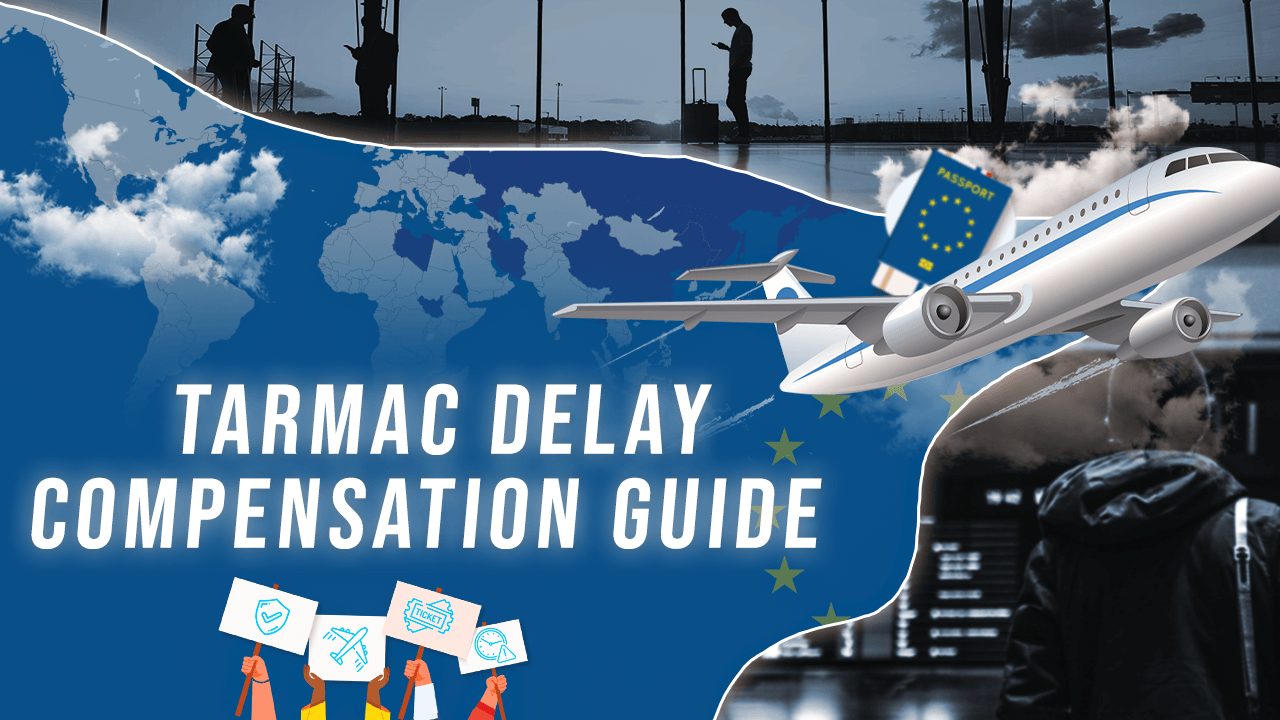Most people think they’re in the clear as soon as they get on the plane, but unfortunately, that’s not the case. You can still face delays while sitting on the tarmac, whether to take off or to get off the plane. If this sounds familiar, you may be entitled to compensation. In this guide, we will delve into the details of tarmac delay compensation, helping you understand when you are entitled to it, how much you can claim, and how to navigate the claim process efficiently. This essential information can empower you as a passenger, ensuring you’re never left in the dark when faced with these frustrating situations. Information in this article was updated in 2025.
Key Takeaways
- Tarmac delays occur when passengers are kept on the plane either before takeoff or after landing. The length of these delays can determine the type of care and compensation passengers are entitled to.
- The regulations regarding tarmac delays vary significantly depending on the country, from the United States to Europe. Being aware of these laws can help passengers ensure their rights are upheld and claim the compensation they are due.
- In the U.S, tarmac delay laws only apply when flying with covered carriers. These airlines operate at least one airplane with seating for at least 30 people and fly to, from, or within the U.S.
- Depending on the duration of the tarmac delay and the country’s laws, passengers may have the right to voluntarily deplane or may be forced to do so. In either case, there are considerations for passengers, like rearranging travel plans and ensuring luggage retrieval.
- If faced with a tarmac delay, passengers can file a claim themselves or work with specialized companies to claim compensation. However, the process and response time can differ depending on the country. Knowledge of this process can empower passengers to assert their rights effectively.
What is Tarmac Delay?
Tarmac delay can be divided into two different categories: take-off or de-boarding.
- You can be stuck on the tarmac as you wait for the plane to take off and start your journey.
- You can also be stuck on the tarmac waiting to get off the plane following your journey.
Both of these constitute tarmac delays, though you’ll want to take into account just how long the delay is to understand if you’re entitled to compensation.
How Long is a Delay?
This depends based on where you are, but in the United States, delays of two hours or more require special care. Passengers must be provided with food, water, restrooms, and medical care.
After a certain amount of time (3 hours in the U.S. and 4 hours internationally), you should be given the option to get off the plane. However, there are exceptions to the rule to protect your health and safety.
Tarmac Delay Laws
The U.S. Department of Transportation has set some tarmac delay laws in place; however, these only apply to flights within the United States. There are also some European laws in place, though they vary from country to country. If you’ve found yourself delayed on the tarmac, look up what regulations apply to you so you can get the compensation you deserve.
Remember, your time is valuable, whether you’re facing a tarmac delay or something more catastrophic.
Covered Carriers
In the United States, you have to be flying with a covered carrier for the tarmac delay laws to kick in. That means that your airline needs to operate at least one airplane with seating for at least 30 people or more and operate to, from, or within the United States. So, if you’re flying an American-based airline and face delays in a foreign country, U.S. tarmac rules do not apply.
How Long Can an Airline Keep You on a Plane?
Once you’re on the plane, ready to take off, time seems to stand still. Any delay can feel like a million years, and the same is true when you’re ready to de-plane and get on with your day. Unfortunately, there are no universal rules for how long airlines can keep you on the plane in either of these situations. The time airlines can keep you on a plan varies from country to country, so if you’re starting to get antsy as you sit on your plane, now’s the time to look it up!
The U.S. Department of Transportation passed regulations to combat unreasonably long tarmac delays in April 2010, and they’ve been changing air travel ever since. Once you hit two hours, you’ll start to receive special care like meals, bathroom access, and more. Any longer, and you may be given the option to get off once safe.
US Tarmac Delay Laws
If your delay is less than two hours, while inconvenient, you don’t have any additional rights. Once you hit that two-hour mark, special accommodations kick in.
- Two hours: Airlines must provide you with food, water, and bathroom access. If you need medical care, they are also legally required to provide it to you.
- Three hours in the U.S.: Passengers should be given the option to deplane.
- Four hours outside the U.S.: Passengers should be given the option to deplane.
Now, there are exceptions to the rule. You won’t be allowed to hop out of the plane if it’s not safe!
European Tarmac Delay Laws
Many European countries have robust flight regulations in place, including in the case of tarmac delays. You may be eligible for compensation under these laws, especially if it caused you to miss a connecting flight. This is stronger than many U.S. regulations. However, the conditions while on the plane vary. Typically, if you’re on the tarmac for:
- 1 hour: Planes are required to turn on the air conditioning, provide access to bathrooms, and offer water to passengers.
- 5 hours: Passengers are given the option to deplane.
Again, the conditions must be safe enough for you to deboard the plane.
International Tarmac Delay Laws
International tarmac delay laws vary based on your country of origin (where the plane is taking off), your destination country (where the plane is landed), and the leg of the flight you’re on.
- If you are on a U.S.-based, domestic flight, then you may be given the option to deplane after 3 hours.
- If you are on a U.S.-based international flight, you may be given the option to deplane after 4 hours.
- If you are in Europe, you may be given the option to deplane after 5 hours.
Some countries allow for additional financial compensation regarding tarmac delays.
Has your flight been disrupted?
Don’t let flight disruption issues cost you – get compensated up to €600!
What Can You Do if You are Stranded on the Tarmac?
Instead of watching the minutes tick down as your flight is delayed, try to stay calm. Everyone is just as frustrated as you are, and there’s no reason you should be outwardly rude to others – even the crew.
-
Know Your Rights
You have rights if your plane is stuck on the tarmac, so take some time to look them up and familiarize yourself. In Europe, after one hour, you start to receive additional rights like access to water, lavatories, and more. In the U.S., similar rights kick in after two hours. From three to five hours, you may be given the option to deplane.
-
Listen
Your pilot and crew have more visibility into the current issues, and there are some circumstances that they may not be able to be transparent in what’s causing the delays. If this is the case and your safety and security are at risk, you will not be able to deplane regardless of the length of time you’ve been on the plane.
-
File a Claim
If you’ve faced a tarmac delay, file a claim. In the U.S., they have 60 days to respond to you. If not, you can register a formal complaint.
What Can You Do if You Have to Deplane?
Deplaning can be tricky, so it’s important to keep the following tips in mind.
-
Voluntary Deplaning
If you are given the option to get off the plane, and you do, it’s your responsibility to arrange for alternative transportation with the airline, though your fare should be transferable. You also need to make sure you grab all your luggage and carry-on items. If you checked luggage, you need to connect with the airline to get it back to you. You would have a lot more responsibility if you chose to get off the plane.
-
Involuntary Deplaning
If you and other passengers are forced to get off the plane, work with the airline on alternative accommodations. They have more onus in this case since it was not your choice to get off the plane, so it’s important that you work with them on alternative accommodations, flights, and more. You may also be entitled to compensation.
How to Claim Tarmac Delay Compensation?
Like other flight delays, you need to file a claim in order to be eligible for financial compensation in regards to your tarmac delay. You can file a claim yourself, or you can work with specialized companies to do so. These companies will only take your case if they believe they can win, so it may be worth the saved headaches to partner with them.
To file on your own, contact their customer support team. In the U.S., they have 60 days to respond to you. If they don’t, you can file a formal complaint with the Department of Transportation. If you’re not in the United States, they may have different requirements. You may be required to provide additional documentation, so be patient.
You can also file through a flight compensation company that is well versed in all flight laws. They look at your case to see if you have a claim. If they accept, you only have to pay if you win. You may be responsible for additional fees if it goes to court, though this varies from company to company. It’s in their best interest to win, so they’ve developed a keen eye on what cases will be successful. You can find the best flight compensation companies bellow.
Conclusion
Tarmac delays can cause major headaches, no matter what stage of the trip you’re on. However, you may be entitled to compensation if the delay is unreasonable, depending on where it occurs. At the very least, you have rights while on the plane to make your accommodations as reasonable as possible.
FAQ
-
What is Tarmac delay compensation?
Tarmac delay compensation is a monetary amount that passengers may be entitled to if they experience a significant delay while waiting on the tarmac either before takeoff or after landing. This compensation is subject to various regulations and rules that differ based on the country and the specific airline.
-
Who is eligible for Tarmac delay compensation?
Eligibility for tarmac delay compensation can vary by country and airline, but generally, passengers experiencing an extended delay on the tarmac may be eligible. In the United States, for example, tarmac delay laws only apply when flying with covered carriers. These airlines operate at least one airplane with seating for at least 30 people and operate to, from, or within the U.S.
-
How much is Tarmac delay compensation?
The amount of compensation can vary significantly depending on the specifics of the delay, the laws of the country, and the policies of the airline. Some countries have robust flight regulations in place that mandate specific amounts for tarmac delays, especially if the delay causes a passenger to miss a connecting flight.
-
How to claim Tarmac delay compensation?
To claim tarmac delay compensation, passengers can usually file a claim directly with the airline. This can typically be done through the airline’s customer service or through their website. Alternatively, passengers can work with specialized companies that handle compensation claims on their behalf. In the U.S., airlines have 60 days to respond to a claim. If they don’t, passengers can file a formal complaint with the Department of Transportation. However, the process and requirements can vary depending on the country.





